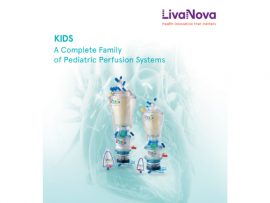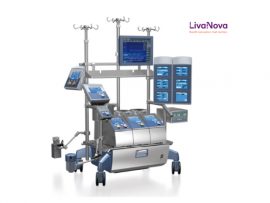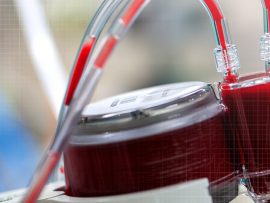Abstract Background Maintaining optimal anesthetic depth during cardiopulmonary bypass (CPB) in pediatric patients is challenging due to altered physiology and unreliable conventional monitoring. Entropy, a processed electroencephalogram metric, offers a..
Read MoreAbstract To investigate the feasibility of regional oxygen saturation (rSO2) monitoring for preventing acute lung injury (ALI)/acute respiratory distress syndrome (ARDS) caused by cardiopulmonary bypass (CPB) in infants undergoing ventricular..
Read MoreAbstract IMPORTANCE: Cardiopulmonary bypass (CPB) surgery is associated with changes in the intestinal microbiome. Metabolism of tryptophan into the indole pathway is entirely facilitated by the intestinal microbiome, and indole..
Read MoreAbstract Background: This study aimed to investigate the effect of operative and postoperative parameters on late-onset hyperlactatemia (LOHL) after cardiac surgery in the pediatric patient population.Methods: One hundred fifty-nine ventricular septal defect..
Read MoreAbstract Over 10% of children develop thrombosis after cardiac surgery for congenital heart disease. Children with a single ventricle physiology have the highest risk of thrombosis associated with increased length..
Read MoreAbstract Objective This study sought to evaluate the value of a CO2 field-flooding device in cardiopulmonary bypass (CPB) surgical procedures for congenital heart disease (CHD) performed via a right-side small incision..
Read MoreAbstract Background Timely recognition of perioperative red blood cell transfusion (PRT) risk is crucial for developing personalized blood management strategies in pediatric patients. In this study, we sought to construct..
Read MoreAbstract Introduction The recently recommended activated clotting time (ACT) to be maintained at the initiation of and during cardiopulmonary bypass (CPB) is ≥480 s. However, the post-unfractionated heparin (UFH) administration ACT..
Read MoreAbstract Background Prophylactic corticosteroids have been widely used to mitigate the inflammatory response induced by cardiopulmonary bypass (CPB). However, the impact of this treatment on clinically important outcomes in infants..
Read MoreAbstract IMPORTANCE: Persistent hypothermia after cardiopulmonary bypass (CPB) in neonates with congenital heart defects (CHD) has been historically considered benign despite lack of evidence on its prognostic significance. OBJECTIVES: Examine..
Read MoreAbstract Introduction Despite technological advances, the use of homologous blood to prime the cardiopulmonary bypass (CPB) circuits of infants under 10 kg remains common. However, such rapid massive transfusion may increase..
Read MoreAbstract Background During cardiopulmonary bypass (CPB), maintaining adequate oxygen consumption (VO2i) can only be achieved indirectly either by modifying oxygen delivery (DO2i) through its component parts or by modulating metabolic demand..
Read MoreAbstract Background: A standard blood prime for cardiopulmonary bypass (CPB) in congenital cardiac surgery may possess non-physiologic values for electrolytes, glucose, and lactate. Pre-bypass Ultrafiltration (PBUF) can make these values..
Read MoreAbstract Background: The during (CPB) to improve Recovery in Infants with (NITRIC) trial, a 1320-patient, multicentre, , is aiming to improve survival free of ventilation after CPB by using nitric oxide delivered into the of the..
Read MoreAbstract Background: The so-called Low Cardiac Output Syndrome (LCOS) is one of the most common complications in pediatric patients with congenital heart disease undergoing corrective surgery. LCOS requires high..
Read MoreAbstract BACKGROUND: Vaso-inotropic agents are frequently used to prevent and/or treat low cardiac output syndrome in infants undergoing surgery for congenital heart disease. Due to the lack of comparative studies,..
Read MoreAbstract Congenital heart disease (CHD) represents one of the most common congenital malformations, affecting greater than 40,000 births annually in the United States, many of which require surgery during the..
Read MoreAbstract Importance Phthalate chemicals are used to manufacture disposable plastic medical products, including blood storage bags and components of cardiopulmonary bypass (CPB) circuits. During cardiac surgery, patients can be inadvertently exposed..
Read MoreAbstract Cardiopulmonary bypass is an integral and indispensable part of surgical repair of congenital heart defects. While the complications and morbidity secondary to the use of cardiopulmonary bypass has decreased..
Read MoreAbstract Introduction A basic prerequisite for a good surgical outcome in heart surgery is optimal myocardial protection. However, cardioplegia strategies used in adult cardiac surgery are not directly transferable to..
Read MoreAbstract BACKGROUND: Bleeding is a serious complication after pediatric cardiopulmonary bypass (CPB) that is associated with an increase in perioperative morbidity and mortality. Four-factor prothrombin complex concentrates (4F-PCCs) have been..
Read MoreAbstract The desired use of the HPH Jr. is optimal due to the low priming volume; however, the lower rate of volume removal necessitates utilization of a larger hemofilter. Larger..
Read More













